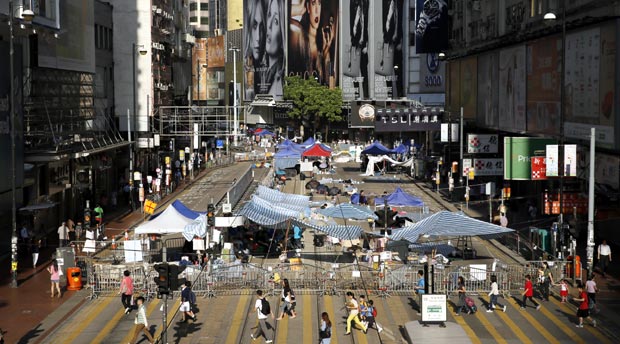Timeline of Hong Kong democracy protests

Students walk past barricades on a main road in the occupied areas at Causeway Bay district in Hong Kong, Friday, Oct. 10, 2014. A pro-democracy protest that has blocked main roads in Hong Kong for almost two weeks could drag on for days yet, after talks aimed at resolving a bitter standoff between the city’s government and student demonstrators collapsed Thursday. AP
HONG KONG- Here are key dates in the recent development of Hong Kong’s pro-democracy movement, leading up to mass protests that brought tens of thousands onto the streets to demand fully free elections:
June 10: Beijing issues a “White Paper” on Hong Kong that — according to democracy campaigners — shows that the city’s much-cherished freedoms could be revoked at any time.
June 30: 800,000 people vote in favor of greater democratic freedoms than Beijing has proposed in an unofficial referendum organized by the protest group Occupy Central.
August 31: China insists on its right to vet candidates for Hong Kong’s next leadership elections in 2017 elections. In response, Occupy Central and other groups vow to embark on an “era of civil disobedience” including mass sit-ins.
September 22: University students begin a week-long boycott of classes.
Article continues after this advertisementSeptember 26: Around 150 student protesters storm government headquarters and occupy a courtyard in the complex. Police use pepper spray to repel them. The protesters defend themselves with their now emblematic umbrellas.
Article continues after this advertisementSeptember 28: With parts of the government complex besieged, Occupy Central joins the students announcing it has begun its civil disobedience campaign. A major street opposite government headquarters is taken over by protesters.
In response riot officers fire tear gas and crowd numbers swell with many apparently moved to join the protest in anger at the police action.
October 1: Celebrations of Communist China’s National Day takes place against a backdrop of noisy pro-democracy protests throughout the city.
October 2: Hong Kong’s leader CY Leung rejects protester demands that he resign but offers to send his deputy to talk to demonstrators.
October 3: Student leaders agree to Leung’s offer of talks. But chaos later erupts in Mong Kok, a busy working-class shopping district taken over by protesters, when government loyalist thugs attack demonstrators.
October 4: Student leaders call off talks, accusing police of failing to act over violent attacks against them. Tens of thousands gather for a mass peace rally in central Hong Kong in response to the assaults.
October 6: Protest numbers dwindle but demonstrators remain in control of barricades across the city. Protest leaders agree to a resumption of talks.
October 8: Leung comes under pressure over his failure to declare two payments totaling HK$50 million ($6.5 million) from Australian engineering company UGL received while in office.
October 9: Democracy activists vow to ratchet up their campaign, joining with pan-democratic lawmakers who vow to gridlock government committees they control. Talks collapse as government pulls out.
October 10: Protesters announce their intention to remain on Hong Kong’s streets for a long term fight as US lawmakers urge President Barack Obama to press their concerns over the lack of democratic development in Hong Kong to Beijing.
RELATED STORIES
Hong Kong protests subside as exhaustion sets in